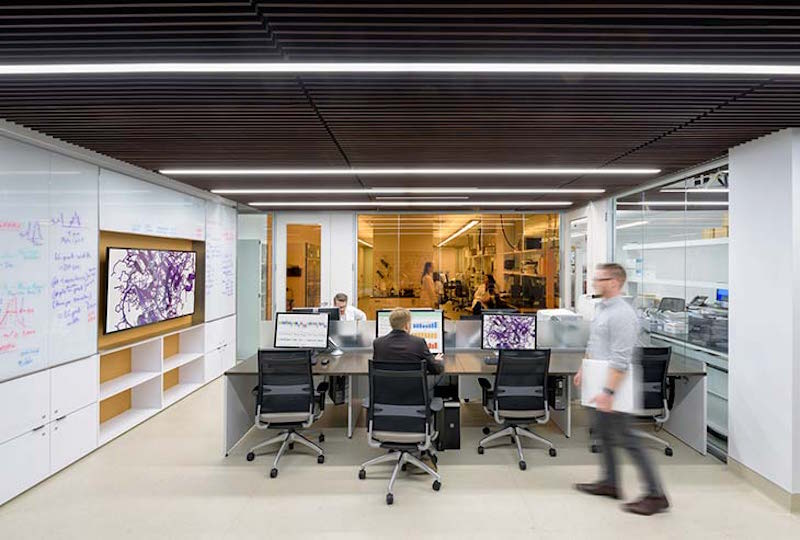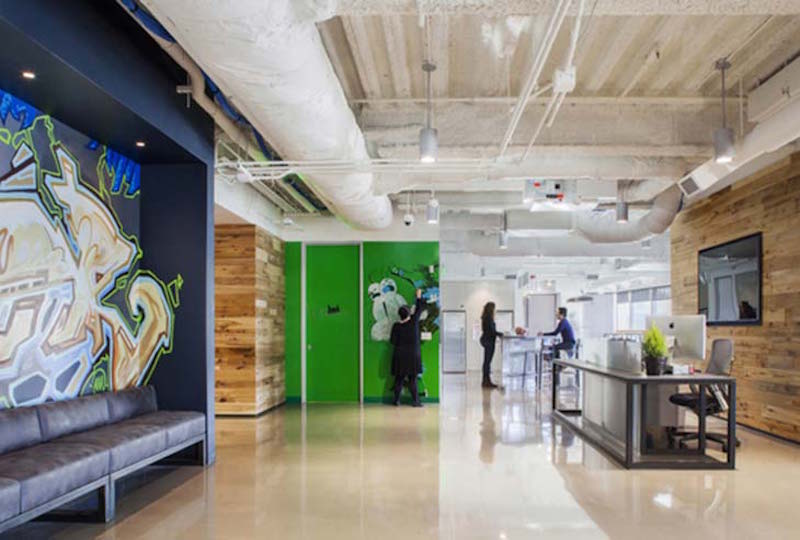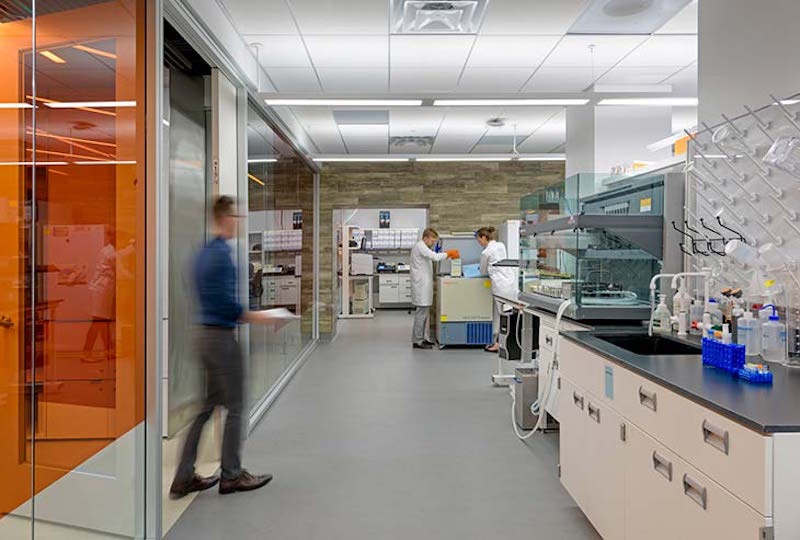When you think of a research lab, you might conjure images of sterile equipment and white lab coats—and there is some truth to that picture. Designing research labs requires meticulous attention to the details of equipment planning, environmental health and safety (EH&S) and the processes that support science. While most labs are designed to achieve that basic functionality, a transformational lab environment prioritizes a science organization’s most valuable assets: its people.
Inspired by the user experience design approach pioneered by tech companies, our design process now considers how scientists initially interact with, and continue to stay engaged with, their environments. Three elements of this user-centric process drive a deeper understanding of the functional necessities to improve the work experience and seed innovation.
Establish a common language
Across the broad array of clients that we work with, the convergence of scientists of different areas of expertise is a common thread. For example, many companies known for chemistry are now using biotech industry techniques to develop their own processes and products. Scientists from different fields have developed distinct dialects, and while there can be similarities among them, the diversity of these dialects creates barriers.
By structuring initial user conversations to encourage engagement, we establish a common language, finding otherwise missed opportunities for optimization. With this strategy, we uncover and break down complex issues and link information, so that the different parties can collaborate and develop shared processes. We find this type of engagement especially useful when working across organizational teams of scientists, engineers, human resources and EH&S professionals.
Find the roadblocks, free the scientists
Due to the specialized nature of their work, scientific users have a hard time defining their needs. In fact, they typically have internal biases or misconceptions that can lead to incomplete or skewed information. For this reason, during the design process we ask that they translate their knowledge and process into user requirements.
Because of project speed and complexity, a lot of initial user requirements are taken from the last time a similar project was developed, which could have been as long as a decade ago. Even if these requirements are updated, they are still based on assumptions and historic precedence at odds with current best practices. Carefully facilitated dialogue with the end users is a highly effective way to establish the needs and requirements that will take the experts and their environments forward.
By nature, scientists will hack their space once they occupy it. By integrating the perspectives of scientists, EH&S, suppliers and facilities engineers early in the process, you move this step to be a part of the design process. Facilitated user discussions uncover operational efficiencies and affinities between programs that would have never been found via a user requirements brief. Having the opportunity to discover obstacles in the daily work of science, both in and outside of the lab, gives leadership the opportunity to set new procedures that will release the scientists to focus on their key mission of developing new therapies and technologies.
 Moffitt Cancer Center. Image © Gensler.
Moffitt Cancer Center. Image © Gensler.
Plan for change
To create a truly efficient and effective laboratory environment, refinement to operations and organizational models needs to align with the new physical environment. Change management becomes critical to helping research organizations realize the gains in operational efficiency and enhanced workplace culture that comes with new facilities. Most clients’ goals include aspects of organizational and process improvement, but they generally don’t dedicate the necessary resources. To accelerate change, we have found that integrating an inclusive change management strategy with the design process is the most effective way to implement innovative and new processes into the scientific work environment.
Because the scale of organization that we often work with is too large for the entire organization to be involved, we have successfully worked with companies to develop a network of Change Champions who own and influence the adoption and integration of new processes. These embedded influencers know the day-to-day needs of their groups and can inform the design from the inside out. They also act as conduits to their colleagues providing information and collecting feedback on changes being developed for their new environment.
By engaging innovators and early adopters as Change Champions, you can disrupt archaic ways of working and push the boundaries of scientific process. These early adopters will communicate and interact with their peers, building consensus and support of new thinking that will ultimately create a transformational laboratory.
 Staples Development Lab. Image © Gensler.
Staples Development Lab. Image © Gensler.
Designing the transformational lab space
User engagement has become a fundamental part of our design process as it uncovers specific needs that wouldn’t have otherwise been found. It establishes the base and pillars required to develop truly transformational research facilities. This is achieved by simplifying and distilling complex information, developing a universal language, challenging conventional thinking and managing change to ultimately develop great science. This approach unlocks opportunities and operational efficiencies beyond the brief, to design environments that enable transformative science.
More from Author
Gensler | Oct 21, 2024
3 surprises impacting the return to the office
This blog series exploring Gensler's Workplace Survey shows the top three surprises uncovered in the return to the office.
Gensler | Jun 26, 2024
5 ways ESG can influence design and create opportunities
Gensler sustainability leaders Stacey Olson, Anthony Brower, and Audrey Handelman share five ways they're rethinking designing for ESG, using a science-based approach that can impact the ESG value chain.
Gensler | May 20, 2024
10 spaces that are no longer optional to create a great workplace
Amenities are no longer optional. The new role of the office is not only a place to get work done, but to provide a mix of work experiences for employees.
Gensler | Apr 15, 2024
3 ways the most innovative companies work differently
Gensler’s pre-pandemic workplace research reinforced that great workplace design drives creativity and innovation. Using six performance indicators, we're able to view workers’ perceptions of the quality of innovation, creativity, and leadership in an employee’s organization.
Gensler | Mar 13, 2024
Trends to watch shaping the future of ESG
Gensler’s Climate Action & Sustainability Services Leaders Anthony Brower, Juliette Morgan, and Kirsten Ritchie discuss trends shaping the future of environmental, social, and governance (ESG).
Gensler | Feb 15, 2024
5 things developers should know about mass timber
Gensler's Erik Barth, architect and regional design resilience leader, shares considerations for developers when looking at mass timber solutions.
Gensler | Jan 15, 2024
How to keep airports functional during construction
Gensler's aviation experts share new ideas about how to make the airport construction process better moving forward.
Gensler | Dec 18, 2023
The impacts of affordability, remote work, and personal safety on urban life
Data from Gensler's City Pulse Survey shows that although people are satisfied with their city's experience, it may not be enough.
Gensler | Nov 16, 2023
How inclusive design supports resilience and climate preparedness
Gail Napell, AIA, LEED AP BD+C, shares five tips and examples of inclusive design across a variety of building sectors.
Gensler | Oct 16, 2023
The impact of office-to-residential conversion on downtown areas
Gensler's Duanne Render looks at the incentives that could bring more office-to-residential conversions to life.
















